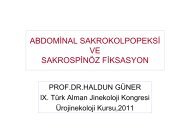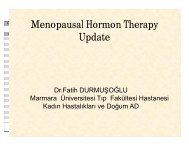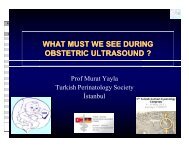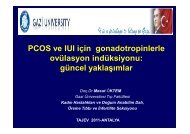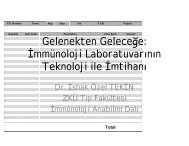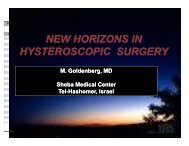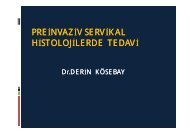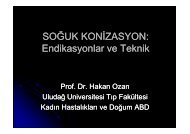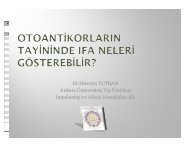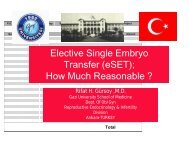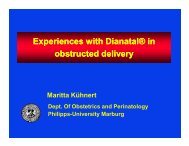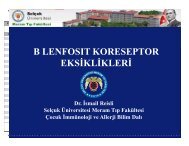Jose Serna Fertility preservation.ppt
Jose Serna Fertility preservation.ppt
Jose Serna Fertility preservation.ppt
Create successful ePaper yourself
Turn your PDF publications into a flip-book with our unique Google optimized e-Paper software.
FERTILITY PRESERVATION<br />
José SERNA, MD, PhD<br />
Director IVI Zaragoza, Spain
Introduction<br />
o<br />
It is estimated that 1/1,000<br />
women between 20 and 30 survive<br />
cancer, frequently after gonadotoxic treatments (CT, RT,…).<br />
o 42% of young women after CT &RT<br />
develop aPOF. 30-90%<br />
men will have seminal changes (Blummenfeld).<br />
o<br />
o<br />
o<br />
1out<br />
of 52 women have amalignant<br />
tumour before 39 yo<br />
In the US there are 50,000000 new cases per year in people in their<br />
reproductive age.<br />
Each year in the US, around 4% of young women receive<br />
treatment with CT &RT<br />
with sterilizing effect.
Introduction<br />
o<br />
o<br />
o<br />
Thanks to the oncologic therapy improvement in the lasts<br />
decades, there is aspectacular<br />
increase in cure rates of some<br />
hematologic cancer and other solid tumours.<br />
Nowadays it is believed that 70% boy and girls with cancer will<br />
survive.<br />
There is aincreasing<br />
concern about the Quality of Life due to the<br />
increase in survival rates after an oncologic treatment.
Introduction<br />
o<br />
The more the survival and cure rate increase, the more the<br />
treatment consequences are taken into account.<br />
o<br />
Ovarian function and fertility maintenance are considered one of<br />
the major concerns among patients overcoming the disease.<br />
These facts influence in Quality of Life and Self-esteem.<br />
“Cancer-free but Sterile”<br />
Oosterhuis et al. Pediatr Blood Cancer 2008;50:85 -89.
Epidemiology<br />
2007 Estimated US Cancer Cases*<br />
Prostate 29%<br />
Men<br />
766,860<br />
Women<br />
678,060<br />
26% Breast<br />
Lung & bronchus 15%<br />
15% Lung & bronchus<br />
Colon & rectum 10%<br />
11%Colon & rectum<br />
Urinary bladder 7%<br />
6% Uterine corpus<br />
Non-Hodgkin<br />
4%<br />
lymphoma<br />
4% Non-Hodgkin<br />
lymphoma<br />
Melanoma of skin 4%<br />
4% Melanoma of skin<br />
Kidney 4%<br />
4% Thyroid<br />
Leukemia 3%<br />
3% Ovary<br />
Oral cavity 3%<br />
3% Kidney<br />
Pancreas 2%<br />
3% Leukemia<br />
All Other Sites 19%<br />
21% All Other Sites<br />
( Higher frequency in reproductive age)<br />
*Excludes basal and squamous cell skin cancers and in situ carcinomas except urinary bladder.<br />
Source: American Cancer Society, 2007.
Epidemiology<br />
Lifetime Probability of Developing Cancer, by Site.<br />
Site<br />
Risk<br />
All sites † 1 in 3<br />
Breast 1 in 8<br />
Lung & bronchus 1 in 16<br />
Colon & rectum 1 in 19<br />
Uterine corpus 1 in 40<br />
Non-Hodgkin lymphoma 1 in 55<br />
Ovary 1 in 69<br />
Melanoma 1 in 73<br />
Pancreas 1 in 79<br />
Urinary bladder ‡ 1 in 87<br />
Uterine cervix 1 in 138<br />
Women, US.<br />
2001-2003*<br />
* For those free of cancer at beginning of age interval. Based on cancer cases diagnosed during 2001 to 2003.<br />
† All Sites exclude basal and squamous cell skin cancers and in situ cancers except urinary bladder.<br />
‡ Includes invasive and in situ cancer cases<br />
Source: DevCan: Probability of Developing or Dying of Cancer Software, Version 6.1.1 Statistical Research and<br />
Applications Branch, NCI, 2006. http://srab.cancer.gov/devcan
Epidemiology<br />
Five-year Relative Survival (%)* during three time<br />
periods by Cancer Site<br />
Site 1975-7777 1984-8686 1996-2002<br />
All sites 50 53 66<br />
Breast (female) 75 79 89<br />
Colon 51 59 65<br />
Leukemia 35 42 49<br />
Lung and bronchus 13 13 16<br />
Melanoma 82 86 92<br />
Non-Hodgkin lymphoma 48 53 63<br />
Ovary 37 40 45<br />
Pancreas 2 3 5<br />
Prostate 69 76 100<br />
Rectum 49 57 66<br />
Urinary bladder 73 78 82<br />
†<br />
*5-year relative survival rates based on follow up of patients through 2003.<br />
†Recent changes in classification of ovarian cancer have affected 1996-2002 survival rates.<br />
Source: Surveillance, Epidemiology, and End Results Program, 1975-2003, Division of Cancer Control and Population Sciences,<br />
National Cancer Institute, 2006.
Breast Cancer<br />
o<br />
o<br />
o<br />
The more frequent tumour in reproductive age is Breast Cancer<br />
accounting 1/3 of the cancers in young women.<br />
More than 15% of Breast Cancers appears in women younger<br />
than 40 (approx. 8,600<br />
new cases/year) and 600 in younger than<br />
30.<br />
The majority of these patients will be treated with CT including<br />
gonadotoxic (CPA) that may generate POF and Sterility.
Gonadotoxic effect<br />
• Age<br />
• Initial state of the gonad<br />
• Cancer type<br />
• Treatment used<br />
- Association of various drugs<br />
- Combined CT % RT<br />
• Doses and number of cycles
Age<br />
Incidence of induced amenorrhoea following CT regarding woman age, in<br />
423 premenopausal women treated with 6 CEF cycles<br />
(cyclophosphamide, epirubicin y 5-fluoruracile).
Gonadotoxic effect<br />
initial gonad condition:<br />
Diseases with impact on ovarian function<br />
• Childhood cancer<br />
• Gynaecological cancer (breast, cervix)<br />
• Previous pelvic radiotherapy<br />
• Benign ovarian diseases<br />
• Prophylactic oophorectomy in inherited mutations<br />
• Autoimmune diseases (lupus, glomerulonephritis)<br />
• Autologous or heterologous hematopoietic precursor<br />
transplantation
Gonadotoxic effect<br />
POF Incidence cancer survivors<br />
Cancer type:<br />
- 1/6 survivor of childhood cancer present POF<br />
- 32% adults surviving Hodgkin<br />
- 44% adults surviving AML<br />
- 50% adults surviving Breast Cancer<br />
- 80% adults surviving BMT<br />
The type of cancer affecting more female fertility is lymphoma<br />
followed by breast cancer.<br />
The following by frequency and/or relevance are: leukaemias,<br />
colorectal cancer, ovary, cervix, bone and thyroid.
Gonadotoxic effect<br />
Chemotherapy<br />
Drugs:<br />
Not following all-or-nothing law<br />
• Drug type: : most toxic agents are alquilants (cyclophosphamide)<br />
acting in an independent cell cycle fashion<br />
• Accumulated dose<br />
• Ages: : around 40% women 40<br />
• CT Mechanism of Action: : few known, but granulose cells seems to<br />
be the main target<br />
• Pathology: : total absence total or very low number of follicles,<br />
inactive, with fibrosis and without signs of follicular maturation
Gonadotoxic effect<br />
Chemotherapy<br />
Agents:<br />
HIGH RISK<br />
INTERMEDIATE<br />
RISK<br />
LOW RISK<br />
Cyclophosphamide<br />
Chlorambucil<br />
Melphalan<br />
Mustine<br />
Cysplatin<br />
Adriamycin<br />
Doxorrubicin<br />
Methothrexate<br />
5-Fluoruracil<br />
Vincristin<br />
Actinomycin D<br />
Bleomycin
Gonadotoxic effect<br />
Antimetabolites<br />
- RT & CT induce an<br />
irreversible destruction of<br />
germ cells leading to a<br />
premature ovarian failure<br />
Alquilants<br />
- Moreover: gonadal<br />
hormones lose,<br />
mutagenesis in germ<br />
cells and/or teratogen<br />
effects<br />
CT leads to primary damage in primordial<br />
follicles
Gonadotoxic effect<br />
Radiotherapy<br />
- Dose received: in humans dose reducing follicular population to half is 2 Gy<br />
- Age<br />
- Irradiation field: probability of POF increases if corporal irradiation<br />
- May have effects on other structures<br />
RT doses and ovarian toxicity, according to age<br />
Dose<br />
Effect<br />
60 no<br />
60-150<br />
>40: possible<br />
250-500500 15-40: 50% sterile<br />
500-800<br />
15-40: 75% sterile<br />
>800 100% sterile<br />
Wallace, 2005
Ovarian injury assessment<br />
Clínica Clinical<br />
- Amenorrhea, irregular cycles<br />
Ecográfica Echography<br />
- Antral follicle count<br />
Analítica Biochemistry<br />
- FSH and estradiol<br />
- Inhibin B<br />
-Antimüllerian hormone (AMH)
Results<br />
• Even with the recovery of ovarian activity, oocyte quality<br />
will be suboptimal<br />
• Higher abortion rates<br />
• Higher IUGR and premature delivery rates in women who<br />
suffered cancer in childhood<br />
European Journal of Cancer<br />
• Systemic treatment (alquilants agents) affects ovary but<br />
not endometrium<br />
• RT has a dose-dependent effect on the ovaries,<br />
endometrium and HPG axis
Pregnancy after Breast Cancer<br />
• Breast Cancer is a hormone-sensitive tumor<br />
• Fear to possible recurrences during pregnancy<br />
• A multidisciplinary team is required to determine the optimal<br />
time to get pregnant and the appropriate strategies<br />
• The time-lapse between cancer diagnosis and pregnancy<br />
varies within each particular case<br />
• Several studies did not find increase incidence of neoplasia<br />
recurrence following pregnancy
Pregnancy after Breast Cancer<br />
Prognosis<br />
• Several studies did not show<br />
increases in mortality after pregnancy<br />
in patients properly treated<br />
• Moreover some found a decrease in<br />
the risk.<br />
• There is a slight increase in<br />
spontaneous abortion in patients who<br />
received CT compared with general<br />
population
Modalities for<br />
<strong>Fertility</strong> Preservation<br />
- Oophoropexy<br />
- Trachelectomy<br />
SURGERY<br />
- Good<br />
MEDICAL<br />
choice CT & RT<br />
- Protective agents<br />
- Embryo<br />
- Oocyte<br />
- Ovarian CRYO Tissue<br />
- (in vitro Maturation)
Ovarian Transposition<br />
(Oophoropexia)<br />
Objective:<br />
Move ovaries away from irradiation field to avoid direct exposition to<br />
radiotherapy<br />
• Laparoscopy or laparotomy<br />
• They can be fixed in the upper paracolic gutters or behind<br />
uterus<br />
• Gonadal protection in 60% of the cases<br />
• Ovarian function <strong>preservation</strong> in 83-88% 88% of the cases<br />
• Complications: vascular lesions, Fallopian tube infarct, cyst<br />
formation
GnRH agonist<br />
Ø FSH/LH<br />
Pituitary<br />
Pituitary<br />
GnRH<br />
agonist<br />
receptor<br />
GnRH<br />
-GnRH agonist may prevent<br />
follicles from reaching the toxic CT<br />
threshold by decreasing mitotic<br />
activity in granulose cells<br />
• It is not clearly established the<br />
benefits of GnRH agonists<br />
• Its use has to be restricted to<br />
controlled clinical assays<br />
Receptor down-regulation<br />
desensibilization<br />
Blumenfeld et al. Fertil Steril 2008;89:166–73
<strong>Fertility</strong> Preservation in People Treated for Cancer<br />
American Society of Clinical Oncology Clinical Practice Guideline<br />
Triage of <strong>Fertility</strong> Preservation Referrals<br />
Assessment of risk for infertility<br />
Communication with patient<br />
Patient at risk for treatment-induced infertility<br />
Patient interested in fertility <strong>preservation</strong> options<br />
Refer to specialist with expertise in fertility <strong>preservation</strong> method<br />
Eligible for proven fertility <strong>preservation</strong> method<br />
Male:<br />
Sperm cryo<strong>preservation</strong><br />
Female:<br />
Embryo cryo<strong>preservation</strong><br />
Conservative gynecologic surgery<br />
oophoropexy<br />
©American Society of Clinical Oncology 2006<br />
Clinical Trial of investigational<br />
fertility <strong>preservation</strong> technique<br />
Cryo<strong>preservation</strong> of testicular or<br />
ovarian tissue or oocytes<br />
Ovarian suppression<br />
http://www.asco.org/guidelines/fertility
Modalities for<br />
<strong>Fertility</strong> Preservation<br />
- Oophoropexy<br />
- Trachelectomy<br />
SURGERY<br />
- Good<br />
MEDICAL<br />
choice CT & RT<br />
- Protective agents<br />
- Embryo<br />
- Oocyte<br />
- Ovarian CRYO Tissue<br />
- (in vitro Maturation)<br />
COH
Ovarian Stimulation<br />
Cryo<strong>preservation</strong>
Letrozole<br />
• Aromatase Inhibitor, 3 rd generation.<br />
• Highly selective<br />
• Decreases E 2 levels in 90%<br />
• Tamoxifen alternative in Breast Cancer<br />
• Recently used for Ovulation Induction, alone<br />
or with FSH<br />
• 5 mg/day more effective than 2,5 mg/day
Tamoxifen vs Letrozole in FIV patients with<br />
Breast Cancer<br />
E 2<br />
hCG<br />
Days<br />
Tamoxifen<br />
Tamox 5 60 mg/d 10<br />
7.8 ± 0.5<br />
Tamox-FSH<br />
FSH 150 IU<br />
Tamox 5 60 mg/d 10<br />
8.9 ± 0.8<br />
Letroz-FSH<br />
FSH 150 IU<br />
Letrozole 5 5 mg/d 10<br />
Letrozole<br />
9.1 ± 0.5<br />
0 4 8 12<br />
Cycle Days<br />
Oktay et al, J Clin Oncol 2005 Jul 1;23(19):4347-53.
Ovarian Stimulation Protocol<br />
with Letrozole<br />
FSH 150 UI<br />
MENS<br />
Letrozole 5 5 mg/d 10<br />
1 2 4 8 12<br />
Letrozole<br />
- GnRH antagonist with follicles ≥14 mm.<br />
- hCG when largest follicles reach 19-21 mm.<br />
- Day+3: E2>250 pg/ml, start Letrozole until E2
Letrozole vs agonist Long Protocol<br />
Table-2. Comparison of various characteristics between letrozole+FSH and control groups.<br />
Letrozole+FSH a<br />
Control b<br />
P-value c<br />
mean ± standard error<br />
mean ± standard error<br />
Age at IVF 36.1 ± 0.5 36.9 ± 0.5 0.69<br />
Baseline FSH 7.6 ± 0.5 4.3 ± 0.2
Letrozole vs. control groups<br />
P=0.05<br />
1<br />
% Maturity<br />
n=2 n=12<br />
17<br />
20<br />
21<br />
0<br />
hCG>17 mm<br />
hCG>18 mm<br />
0.53 ± 0.18 vs. 0.80 ± 0.05<br />
Mature/ Total Oocytes<br />
Fertilization<br />
Oktay et al, JCEM 2006<br />
17<br />
20<br />
21
Controversies Letrozole<br />
• 4.7 vs 1.8% major malformations<br />
• 150 NB after Letrozole vs 36.000 NB, in an NON-TERTIARY hospital<br />
• Laryngomalacia, craneosynostosis, sacral fusion, aortic stenosis (2), cystic<br />
lynphangioma, hepatocellular carcinoma.<br />
• Only slightly increased Chromosomal Abnormalities.<br />
ASRM 2005 abstract<br />
• 911 NB after Letrozole or Clomiphene stimulation<br />
• Similar malformation rates: 2,4% (L) vs 3% (CC).<br />
• Less incidence of hart malformation (0,2% vs 1,8%, p=0,02).<br />
Tulandi-Casper. Fertil Steril, June 2006.<br />
• 2.56% (L) vs 3.10% (CC) major malformation (p>0.05).<br />
Padte K et al. Serono Symposia on Regulation of Follicle Development and its Clinical Implications. May 2006.
Controversies Letrozole<br />
• Half-life: 48h<br />
- Drug out of the body before<br />
fertilization.<br />
• Absence of evidence of<br />
oocyte/embryo damage in mice<br />
• Cryopreserved embryos are not<br />
exposed to the drug<br />
Novartis:<br />
The drug “should not be used in<br />
women who may become<br />
pregnant, during pregnancy<br />
and/or while breast-feeding,<br />
because there is a potential risk<br />
of harm to the mother and the<br />
fetus, including risk of fetal<br />
malformations,”
Utilization of IVM Further Increases<br />
the Yield of Oocytes & Embryos in<br />
Letrozole Cycles<br />
% of cryopreserved embryo/oocytes<br />
14<br />
12<br />
10<br />
8<br />
6<br />
4<br />
2<br />
0<br />
Before IVM<br />
After IVM<br />
Before IVM<br />
After IVM<br />
Embryo or oocyte yield increase 44.7±11.2 % (p
Oocyte in vitro Maturation<br />
Pros<br />
-Simple and short time<br />
-Low cost<br />
-Low incidence of side-effects<br />
Cons<br />
- Less successful rates<br />
- Difficult uptake<br />
- Still experimental
<strong>Fertility</strong> Preservation in People Treated for Cancer<br />
American Society of Clinical Oncology Clinical Practice Guideline<br />
<strong>Fertility</strong> Preservation Options in<br />
Females (cont’ d)<br />
• Embryo Cryo<strong>preservation</strong><br />
– Requires ~2 weeks of ovarian stimulation w/daily injections of FSH from<br />
the onset of menses.<br />
– A delay of 2-6 weeks in chemotherapy initiation may be required if<br />
reproductive specialists do not see women early in their menstrual<br />
cycle.<br />
– This approach may be associated with high out-of-pocket costs for most<br />
women.<br />
– Long-term follow up with a larger number of patients is needed to<br />
evaluate the safety and efficacy of this approach.<br />
– For women with hormone-sensitive tumors, alternative hormonal<br />
stimulation approaches such as letrozole or tamoxifen have been<br />
developed to theoretically reduce the potential risk of estrogen<br />
exposure.<br />
http://www.asco.org/guidelines/fertility<br />
©American Society of Clinical Oncology 2006
<strong>Fertility</strong> Preservation in People Treated for Cancer<br />
American Society of Clinical Oncology Clinical Practice Guideline<br />
<strong>Fertility</strong> Preservation Options in<br />
Females (cont’ d)<br />
• Recommendation (Embryo Cryo<strong>preservation</strong>):<br />
–Embryo cryo<strong>preservation</strong> is considered an<br />
established fertility <strong>preservation</strong> method as it has<br />
routinely been used for storing surplus embryos<br />
after in vitro fertilization for infertility treatment.<br />
http://www.asco.org/guidelines/fertility<br />
©American Society of Clinical Oncology 2006
Oocyte Vitrification<br />
Cryotop Method
Vitrified oocytes maintain intact their potential to reach blastocyst
Perinatal outcome from Vitrified vs. Fresh donated oocytes.<br />
Paired cohorts study.<br />
Singleton<br />
Vitrified<br />
Singleton<br />
Fresh<br />
Multiple<br />
vitrified<br />
Multiple<br />
Fresh<br />
Nº Deliveries 212 234 99 92<br />
Nº New born 212 234 199 183<br />
Nº Live birth 211 233 197 183<br />
Mean maternal age at delivering 40.6 ± 4.9 40.8 ± 4.8 40.8 ± 3.4 40.4 ± 4.5<br />
Mean gestational age (weeks) 39.0 ± 1.9 38.6 ± 1.9 36.7 ± 2.8 36.1 ± 2.2<br />
No. of deliveries at
Modalities for<br />
<strong>Fertility</strong> Preservation<br />
• Recommendation (Oocyte Cryo<strong>preservation</strong>):<br />
–Cryo<strong>preservation</strong> of unfertilized oocytes is another option<br />
for fertility <strong>preservation</strong> particularly in patients for whom:<br />
•A partner is unavailable, or<br />
•Religious or ethical objections conflict with embryo<br />
freezing.<br />
- Embryo<br />
- Oocyte<br />
- Ovarian Tissue<br />
- (in vitro Maturation)<br />
COH
Modalities for<br />
<strong>Fertility</strong> Preservation<br />
CRYO<br />
- Embryo<br />
- Oocyte<br />
- Ovarian Tissue<br />
- (in vitro Maturation)<br />
COH
<strong>Fertility</strong> Preservation and Cancer<br />
OOCYTE<br />
CRYOPRESERVATION<br />
OVARIAN CORTEX<br />
CRYOPRESERVATION<br />
Advantages:<br />
-Demonstrated results<br />
-Success Rate similar to fresh<br />
oocytes<br />
-Established technique<br />
Advantages:<br />
-Unlimited cycles<br />
-Maintenance Hormone<br />
function<br />
Restrictions:<br />
-Limited IVF cycles<br />
-Does not guarantee pregnancy<br />
-May delay CT<br />
-Need ovarian stimulation<br />
Restrictions:<br />
-Isolated cases<br />
-Need tech optimization<br />
-Harboring cancer cells<br />
-Need surgery
<strong>Fertility</strong> Preservation in Cancer Patients<br />
1 st choice<br />
OOCYTE<br />
CRYOPRESERVATION<br />
OVARIAN CORTEX<br />
CRYOPRESERVATION<br />
-Women willing to conceive<br />
-Oncologist consultation<br />
and approval<br />
-Does not exclude ovarian<br />
cortex removal<br />
Concerns:<br />
-Cross-contamination<br />
-Girls<br />
-Contraindication for<br />
ovarian stimulation<br />
-Oncologist disapprove<br />
stimulation<br />
-No time for ovarian<br />
stimulation<br />
Concerns:<br />
-Leukaemia<br />
-Cross-contamination
Ovarıan Cortex Cryopreservatıon<br />
• Still experimental<br />
• Animals and Humans<br />
spontaneous<br />
pregnancies<br />
• Ovarian cortex is fully<br />
functional
Ovarian tissue cryo<strong>preservation</strong><br />
Our protocol<br />
Ovarian cortex retrieval (generally by laparoscopy) and ulterior processing
Ovarian cortex cryo<strong>preservation</strong><br />
Our protocol<br />
• Reimplantation over ovarian medulla when disease-free have<br />
been proved<br />
Limitations<br />
• Avoid massive follicle loss associated with transplantation<br />
isquemia:<br />
• Surgical approaches<br />
• Antiox. and angiogenic agents<br />
• Define biological hazard markers before reimplantation
IVI Program for Female<br />
<strong>Fertility</strong> Preservation<br />
Cancer diagnosis<br />
Ovarian tissue freezing<br />
Ovarian stimulation<br />
Egg vitrification<br />
3 weeks
<strong>Fertility</strong> Preservation in People Treated for Cancer<br />
American Society of Clinical Oncology Clinical Practice Guideline<br />
http://www.asco.org/guidelines/fertility
“No childless women<br />
surviving cancer”



![Engin Oral_Konjenital uterus anomalileri.ppt [Uyumluluk Modu]](https://img.yumpu.com/51729800/1/190x146/engin-oral-konjenital-uterus-anomalilerippt-uyumluluk-modu.jpg?quality=85)
